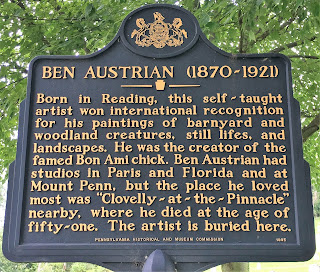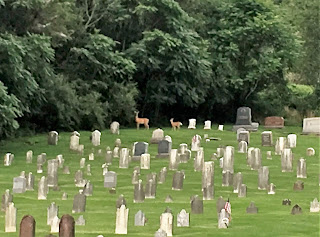I'm pretty familiar with the tiny community of Kempton. I used to volunteer monthly at Hawk Mountain, which dominates the landscape. Every fourth Sunday I'd drive through Kempton, an extremely pretty place at the foot of the Kittatinny Ridge mountains, and judge how close I was to being late for my shift by the visual landmarks along the way. One thing that always caught my eye was the distant hill dotted with white headstones; I always thought to myself that I should drive over sometime and actually have a look at Historic New Bethel Church (as the sign calls it), but I never got around to actually doing so.
Then this blog happened, and there turned out to be a marker there, so I finally made the drive.
 |
| The marker is on New Bethel Church Road, at the base of the cemetery hill between the trees |
It was a cloudy, overcast day; the rain had stopped by the time I entered Berks County, but the roads were still wet and a heavy shroud of mist obscured the pinnacle of Hawk Mountain in the distance. I turned my "window office" onto New Bethel Church Road and headed toward the cemetery hill that had so often beckoned to me. I had to admit to being puzzled, because I'd never even heard of Ben Austrian, but it turns out he's a pretty interesting guy.
As his marker indicates, Benjamin Franklin Austrian was born in the city of Reading on November 22, 1870. He was the fifth son of Raphael Austrian, a German Jewish immigrant who owned a dry goods store on Penn Street. Raphael is credited as an instrumental founder of Oheb Sholom Synagogue, which was established in Reading on May 1, 1864, and is currently based out of nearby Wyomissing; it is the oldest Jewish synagogue in Berks County. His wife, Ben's mother, was Fannie Elizabeth Dierfross, a member of the wealthy Drexel family of Philadelphia, whose cousin Anthony founded Drexel University.
Ben, which is what I'm going to call him since that's what most of the sources I read call him, was a sickly child. He wasn't allowed to play outdoors with his friends because of his poor health, and often spent summers on a farm in nearby Kutztown. This is where Ben developed his lifelong affection for chickens. I'm not making that up; he enjoyed watching the mother hens herding their broods and started to learn to paint in order to capture their likenesses. Later in life, when asked why he painted chickens so much, he replied simply, "I paint chickens because I love them."
As a teenager he went to work for his father, both in dry goods and steam cleaning, but he continued to paint in his spare time. He was an entirely self-taught artist, never pursuing any sort of professional instruction in the subject, although he did visit major art institutions in big cities to learn from the works they displayed. Sometimes he would give his paintings to customers to sweeten business dealings, which is pretty clever if you think about it. I mean, he had to have cornered that market.
 |
| I had unexpected company for my cemetery visit in the form of Pennsylvania's state animal |
Raphael Austrian died in 1894, and Ben took over his job, but very soon realized that the dry goods life wasn't really for him. He sold the shop, using the profits to ensure his mother's comfort, and began painting in earnest. He assembled his own flock of chickens, training them to pose for him, and also painted other livestock and country scenes; his painting "After the Race" won a $100 prize just a year after his father died. Earle's Art Gallery in Philadelphia hosted Ben's first exhibition in 1898. He began doing commercial works of art; Whitman's Chocolate, Mumm's Extra-Dry Champagne, and Corticelli Thread were among the late-19th century companies who purchased his art for advertising.
In 1900, Ben became a renowned painter of chickens when he accepted a commission from A. W. Erickson, who paid him to use his chicken images in advertising. Ben became the official artist for Bon Ami, a feldspar-based cleanser which still today uses a baby chick as its mascot. They hired him to not only paint chickens for their advertisements, but also pictures of housewives using the product, and his wife Mollie served as the model in these images. Beyond his commercial work, Ben continued to make and sell paintings of chickens and other livestock; one of his paintings, "Golden Harvest," was purchased by the Walker Museum of Art in Liverpool, England, which brought him international acclaim.
Ben was a pretty clever guy. Having learned business sense in his father's shop, and having already had creative ideas about sales as illustrated by his giving pictures to customers, he began making lithographs of his paintings, which allowed them to be more widely distributed. The Ben Austrian Art Publishing Company was eventually established to handle the requests for these lithos, which were in demand both in the United States and Europe, and which are still considered collector's items today.
Ben and Mollie lived chiefly in Berks County, on Neversink Mountain, where he maintained his chief studio. He also had a studio in Paris, and a winter cottage in Palm Beach, Florida, where he painted landscapes of sand and palm trees. But his favorite place was "Clovelly-at-the-Pinnacle," a log cabin in Albany Township once belonging to Daniel Boone's family, which was his summer retreat and where he painted many of his works. Apparently it's not known just how many paintings he made during his lifetime, and part of the problem is that a lot of his works didn't have titles, which makes cataloguing them difficult. An original Ben Austrian painting, depending on the condition, can fetch a price up to six figures.
 |
| Ben's grave is about midway up the hill on the northern side of the church |
Ben died very suddenly of a heart attack on December 9, 1921. Although of Jewish descent, and having direct connection to the synagogue in Reading, he's buried at the New Bethel Church among its Lutheran population. This didn't make much sense to me until I read about his fondness for the location; it seems our friend Ben liked to stand exactly where he's buried and watch the sun set over the Pinnacle, for which his retreat was partially named. The Pinnacle is a local overlook, part of the Appalachian Trail, and the highest point in Albany Township. They say that if you stand at Ben's grave and look toward Clovelly, you have a direct view of the Pinnacle.
I climbed the cemetery hill in search of Ben's grave. It's easily found, being fairly large and displaying his name very prominently. The weather being what it was, I knew I had no hope of seeing the Pinnacle; but the view was pretty impressive anyway.
 |
| The low hanging clouds on the right are obscuring the reaches of Hawk Mountain |
In addition to the sources listed below, some of Ben's work can be viewed at the Historical Society of Berks County. Also, every October, Greshville Antiques and Fine Art has a week-long show and sale of art by Berks County natives - Ben's a prominent part of the offerings.
Sources and Further Reading:
Ben Austrian at Artnet.com
Austrian, Geoffrey D. Ben Austrian, Artist. Garrigues House Publishers, 1997. (The author is Ben's great-nephew.)
"Ben Austrian, World Renowned Artist" by Britany Maack. Part of the Rewriting Local Histories: Racial, Ethnic, and Cultural Communities series of articles published by the Pennsylvania State University. Publication date unknown.
Reading Eagle retrospective about Ben Austrian - includes a portrait of the artist.
The History of Oheb Sholom Synagogue, written in 1939 for the congregation's 75th anniversary program
Ben Austrian on LancasterFarming.com
New Bethel Church at FindAGrave.com
Ben Austrian at the Historical Marker Database
If you've enjoyed this, please leave a comment!
Except where indicated, all writing and photography on this blog is the intellectual property of Laura Klotz. This blog is written with permission of the Pennsylvania Historical and Museum Commission. I am not employed by the PHMC. All rights reserved.

No comments:
Post a Comment
I would love to hear from you!